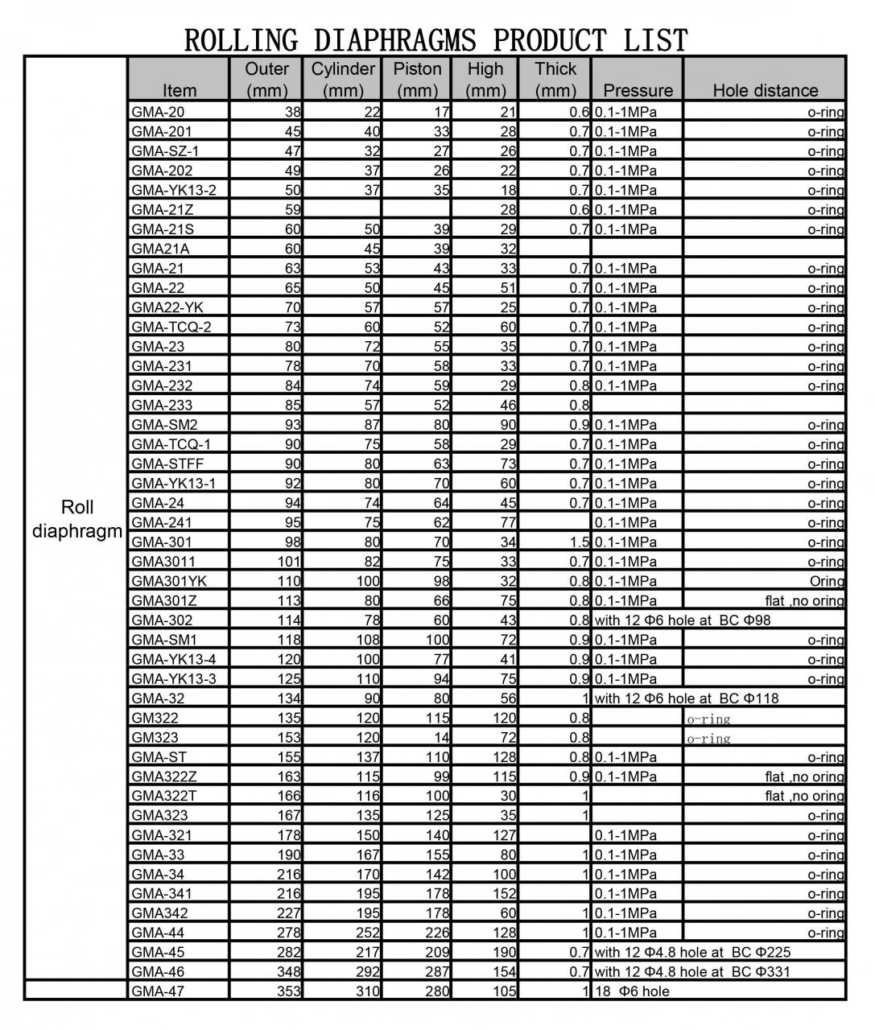Rolling Diaphragm is a device that uses a flexible, usually cylindrical diaphragm as the active component to move a plunger or gate in a linear motion. In this design, the diaphragm is moved by a motor and rollers, which create a rolling wave motion that drives the diaphragm and plunger in a linear path. This type of device is typically used in hydraulic or pneumatic applications for controlling pressure regulation and flow control.
Customers’ drawings or samples are always welcome for quote and manufacture.
| Diaphragm | ||
| Function | Seal for Automotive, Machine, Valve, Electrical Appliances, etc. | |
| Material | NR, NBR, HNBR, EPDM, Silicone, ACM, AEM, FKM, FVMQ, etc. diaphragm for regulator | |
| Color | Black (recommended), but other color available | |
| Hardness | 20~90 Shore A diaphragm for regulator | |
| Certificates | RoHS, PAHS, REACH, FDA, KTW, NSF, WRAS, CCS, EN681-1, National Sanitary Certificate | |
| Size | DN max = 2000mm, all other smaller sizes will per customer demands diaphragm for regulator | |
| Properties (Optional and Multiple) |
Oil Resistance, Chemical Resistance, Steam Resistance, Aging Resistance, Heat Resistance, Cold Resistance, Fire Resistance, Environment Protective, Strong Resilience, Abrasion Resistance, etc. | |

Rolling diaphragm

—————————–
Tags: PTFE diaphragm
What fields and applications is Rolling Diaphragm suitable for? How does it work?
Rolling diaphragm is a flexible diaphragm or bellows used in various fields and applications. This type of diaphragm is made of thin and flexible materials such as rubber, silicone resin, or fabric, and reinforced by structural support. It responds to changes in pressure by bending and moving, generating displacement or transmitting force.
1. Rolling diaphragms are commonly used in cylinders, serving as flexible walls that expand and contract in response to the pressure of compressed gas. This can achieve precise and controlled movement of the oil cylinder.
2. Rolling diaphragms are also used in hydraulic systems to help control fluid flow and convert pressure into motion in hydraulic cylinders.
3. It can be used for various medical and health equipment, such as blood pressure monitors, oxygen tanks, and respirators. In these devices, the diaphragm helps to measure and control pressure, gas, and fluid.
4. It is also used in pump and valve systems to help regulate and control fluid flow. They are usually used in conjunction with other types of diaphragms, such as pistons or flat diaphragms.
5. Some consumer electronics products, such as headphones and microphones, use rolling diaphragms in their transducer components to convert sound into electrical signals.
6. It is also commonly used in the automotive industry, including throttle control, cruise control, and suspension systems. The flexibility and durability of these diaphragms make them very suitable for use in harsh environments.
In the aerospace industry, it includes aircraft fuel systems, pneumatic and hydraulic systems, and rocket engines.
The main mechanism of rolling diaphragm is to transfer pressure or force from one side of the diaphragm to the other. When pressure is applied to one side, the diaphragm will bend and move, causing displacement or transmitting force through the diaphragm.
Its working principle is different from other types of diaphragms because they are designed in a rolling or spiral shape. This design allows for a larger surface area to be exposed to pressure, thereby more effectively transmitting force or pressure. It also allows for greater flexibility and fatigue resistance, making the rolling diaphragm suitable for long-term use in demanding applications.
The flexibility and rolling effect of the diaphragm ensure that fluid or gas will not leak, even if there is relative motion between the separated components of the diaphragm.
The rolling diaphragm is designed to handle various types of motion, including linear, oscillating, and rotating, making it suitable for applications with dynamic sealing requirements.
What are some things to pay attention to when using Rolling Diaphragm? What is its maintenance method?
What precautions should be taken when using rolling diaphragms? What is its maintenance method?
When using rolling diaphragms, these precautions should be taken:
1. Material compatibility: Ensure that the rolling diaphragm material is compatible with the fluid or gas used. Exposure to incompatible materials can cause diaphragm expansion or degradation, leading to failure.
2. Pressure and temperature limits: Pay attention to the pressure and temperature limits of the rolling diaphragm. Exceeding these limits may cause rupture or deformation of the diaphragm, leading to a loss of system function.
3. Installation: Ensure that the rolling diaphragm is installed correctly according to the manufacturer’s guidelines. Improper installation may lead to leakage or premature failure.
4. Avoid contamination: Keep the rolling diaphragm clean and free of any debris, dirt, or oil. Pollution can damage the flexibility of the diaphragm and lead to failure.
5. Avoid excessive stretching: Avoid excessive bending or stretching of the rolling diaphragm, as this can lead to fatigue and premature failure.
The maintenance methods for rolling diaphragms include:
1. Regular inspection: Regularly inspect the rolling diaphragm for signs of wear, cracks, or deformation. If any problems are found, please replace the diaphragm immediately.
2. Cleaning: Keep the rolling diaphragm clean and free of any pollutants or debris. If necessary, clean with a soft cloth and mild cleaning agent.
3. Lubrication: Apply a thin layer of lubricant on the surface of the diaphragm to reduce friction and prevent wear.
4. Timely replacement: Replace the rolling diaphragm at the recommended intervals, or if there are any signs of wear or damage, replace the rolling diaphragm.
5. Storage environment: Store the rolling diaphragm in a clean and dry environment, away from direct sunlight or heat sources.

